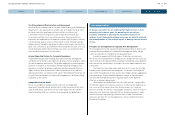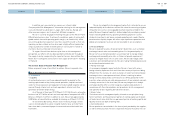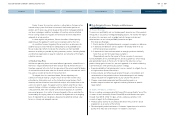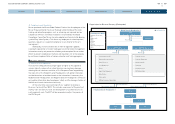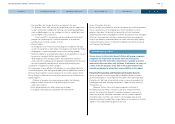Nissan 2013 Annual Report Download - page 44
Download and view the complete annual report
Please find page 44 of the 2013 Nissan annual report below. You can navigate through the pages in the report by either clicking on the pages listed below, or by using the keyword search tool below to find specific information within the annual report.
Nissan has promoted countermeasures based on three basic principles
stated in the global policy, which are:
1. First priority on employees’ health and lives
2. Prevention of the spread of infection
3. Continuity of business operation
As specific actions, Nissan established the “guidelines for employees’
action” which stipulated actions to be taken by employees, Sections and
Companies, and kept employees informed.
Nissan also developed a Business Continuity Plan (BCP) for each
business section, with several triggers to invoke the BCP depending on
the infection ratio, to maintain business continuity even under a high
infection situation.
Nissan will keep prepared for contingencies like avian flu through its
PDCA cycle, such as by updating response team members and the BCP,
carrying out educational activities for infection prevention and stockpiling
sanitary and medical goods.
3) Countermeasures for Production Continuity Risk
Nissan’s production division has dealt with various risks related to the three
elements of production, as listed in the chart at right. Particularly for natural
disasters, we have identified the measures needed to restart production within
our established goal of two weeks following a large-scale disaster. We have
worked over the years on continuous prevention countermeasures to physical
infrastructure (quakeproofing and reinforcement of buildings and other
facilities), maintained an operations recovery manual to shorten recovery time
and regularly executed BCP simulation drills. We are also strengthening the
resilience of our global production network by establishing a BCP for parts
exports to enable continued operations at our overseas plants.
In addition to such countermeasures to natural disasters, it is absolutely
important to manage risks associated with parts procured from Leading
Competitive Countries (LCCs) in order to expand markets globally. To deal
with such risk, Nissan has been conducting risk assessment before making
sourcing decisions, providing support for improvement activities after
sourcing, implementing quality checks at key points in the production and
logistics process to prevent the production and utilization of imperfect parts
and undertaking activities to confirm and help improve supply capacity in
order to secure global market expansion and growth. Specifically, in addition
to existing organizations to manage supplier risk in North America, Europe
and Japan, new bodies are being created in Thailand, China and India to
reinforce our global efforts to prevent risks associated with the supplies of
parts.
HR/Workforce Purchased parts/
Raw materials Facilities
Risk factor
Natural disasters
(earthquakes)
l Reinforcement of office buildings (completed)
l Development of earthquake response manual,
implementation of evacuation drills (once/year)
l Conducting of disaster prevention drills (once/year
or more)
l Assessment of earthquake preparedness of major
suppliers located in high quake-risk areas (FY08)
l Planning to adopt damage reporting system on web
base (FY10)
l Confirmation of BCPs to be implemented at time of
disaster by suppliers in high quake-risk areas
(FY11)
l BCP for parts exports to continue production at
overseas plants (FY12)
l Reinforcement of buildings & machinery
(continued)
l Regular audits of each business facility
l Review of facility recovery manual (FY11)
Fire l Risk assessment based on F-PES (Fire Prevention
Evaluation System) (once/year)
l Same as on the left l Same as on the left
l Revision of equipment standard based on the
assessment result
Workplace injury l Risk assessment based on SES (Safety Evaluation
System) (once/year)
l Assessment for health & safety management
system (once/year)
l Same as on the left l Same as on the left
Pandemic l Development of flu response manual (FY09) l Requested suppliers to develop response manual
coordinated with Nissan
Demand fluctuation l Backup from other Nissan plants (as needed)
l Backup from other companies (as needed)
l Employment of short-term employees (as needed)
Regular check of demand projection and supply
capacity; implementation of measures
l Installation of flexible manufacturing system
(completed)
l Regular check of demand projection and production
capacity; implementation of measures
l Development of complementary production system
for main powertrains
Machinery breakdown l Share past incident experiences and reflect them in
preventive maintenance
l Reflect them in equipment standards
Electric power shortage l Thoroughgoing energy conservation efforts
l Flexibility in plant operations and working hours in
response to requests from the government or
power companies
Expansion of LCC-
manufactured parts
l Assessment of monozukuri ability before supplier
sourcing and support for improvement activities
after sourcing
l Quality assessment at production preparation phase
l Quality check at mass production phase (action
“Gate 1-3”)
l Establishment of organization for supplier risk
management at operations in major LCCs (FY12)
Decrease of skilled
workers/experts
l Planning and implementation of training program at
each plant to develop skilled workers (FY10)
l Global development of human resources through the
Global Pilot Plant program (FY11)
l Development of experts to teach technical skills
(planning and implementation from FY12)
3 elements of
production
43
CORPORATE GOVERNANCE
NISSAN MOTOR COMPANY ANNUAL REPORT 2013
CONTENTS
MANAGEMENT MESSAGES
CORPORATE FACE TIME
PERFORMANCE
NISSAN POWER 88



